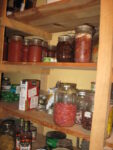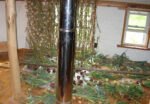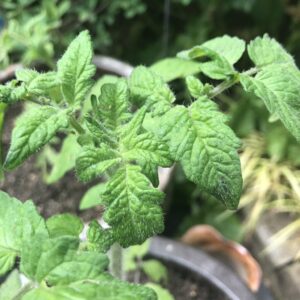A version of this column first ran in the Roane County (WV) Reporter and Times Record. Support local journalism! Subscribe to your local newspaper. This is one of a series of blogs for new gardeners. Read the rest: Part 1. Part 2. Part 3. Part 4. Part 5. Part 6. Part 7.




“Tomatoes! When’s she gonna talk about tomatoes?” Actually the plant family known as solanaceae or nightshades, includes four common garden vegetables: potatoes, peppers, eggplants and tomatoes. All are tender plants, but frost dates should be long gone until fall.
We talked about potatoes in March, and hopefully you’ve got yours in the ground, maybe coming up now—if they’re six inches high you might hoe dirt onto them to cover them more deeply. Otherwise you’ll want to mulch them heavily, whenever you find some good mulch. That’s about all they need. They may get little holes from flea beetles along with the brassicas, but these usually go away before they do much damage. Some years potato beetles can be a problem, but not this early.
I don’t grow eggplants, since I noticed we don’t eat them, but they aren’t hard to grow, except for one thing: flea beetles prefer them over all else in the world and can hit them so hard there’s no leaf left. The only solution I know is to cover the eggplant patch with some kind of row cover. This is gauzy material something like cheesecloth, available in garden supply places. It comes in different thicknesses and is also used for frost protection. You want the lightest grade for insect protection—and you have to tuck it into the ground. This can also be good for protecting the brassicas (cabbage family) against the worms. You can reuse it for a couple of years.
Usually, nothing bothers peppers. Depending on varieties, they should be 18 inches to two feet apart, same with eggplants. They want pretty good soil and full sun. I find that the cages sold for tomatoes are too small to be effective for tomatoes, but they may work well for peppers, which often lean or fall over. Sometimes peppers dawdle for months and don’t get serious about putting out fruit until September, but other times you get fruit in July. I like to grow several varieties, both sweet and hot ones.
Tomatoes—the number one favorite garden plant, probably because there really is no comparison between those bland mealy tomatoes you buy and the rich, juicy vine-ripened ones from your own backyard. Tomatoes come in determinate and indeterminate varieties. The determinate ones ripen a lot of fruit at once and then peter out, which is good for places with short growing seasons or canners—but I can a lot of sauce and I mostly grow the indeterminate ones so I can keep harvesting fruit until it frosts. There are also paste tomatoes, which have less juice and seeds and are mainly for processing—so I always grow some of those—and cherry tomatoes, for snacking on. You can get green, gold, red, and blackish tomatoes. Me, I’m always looking for the rich tangy flavor I remember from yesteryear, and I find the black ones generally best—Pink Berkeley Tie-Dye is a new favorite, and now Chocolate Chestnut. Kellogg’s Breakfast, a WV heirloom, is not sour enough for me but is wonderfully sweet, and orange. Generally, the hybrids have better disease resistance but you can’t save seed and expect the same type—and I think the heirlooms have better flavor.
If you can, give your tomato plants a shovel of manure or compost in each hole, put them two or three feet apart, and plant them in cages. I once read that you get the maximum yield if you just let them sprawl—that must not take into account that half the fruits rot. You can lash a tomato to a stake, read it its rights and—no, tie it to a stake and then you have to prune it. I like a stout, tall cage so I don’t have to prune or tie it. It will climb up in the cage without help. I made cages out of field fence, here’s how: count ten sections and snip apart with heavy cutters. Now you have one cage. You must also cut off the heavy end wire from the side with the bigger squares. Now roll it into a cylinder and bend the protruding half-wires over to fasten it. You should have a cylinder 18 inches in diameter with six inch prongs sticking out one end. You’ll use these to anchor it in the ground. Then you can reach into the squares to pick fruit—the smaller gaps at the upper end don’t matter because you can just reach in through the top.
Now my confession—I have by far my greatest disease problems with tomatoes. Septoria blight, early blight, and lately I’ve seen late blight as well. Some varieties have some resistance, and you can: mulch early; keep the plants farther apart; not plant where tomatoes were the last three years; pluck off lower leaves, because the diseases climb up from the ground. In my experience all this delays, but does not stop the diseases. But the plants don’t actually die, and continue producing some fruit for many weeks. As for bugs, you may have minor flea beetles issues early and tomato hormworms, but while these latter are big remarkable caterpillars, there are never enough to do real damage. My chickens consider them a delicacy.













